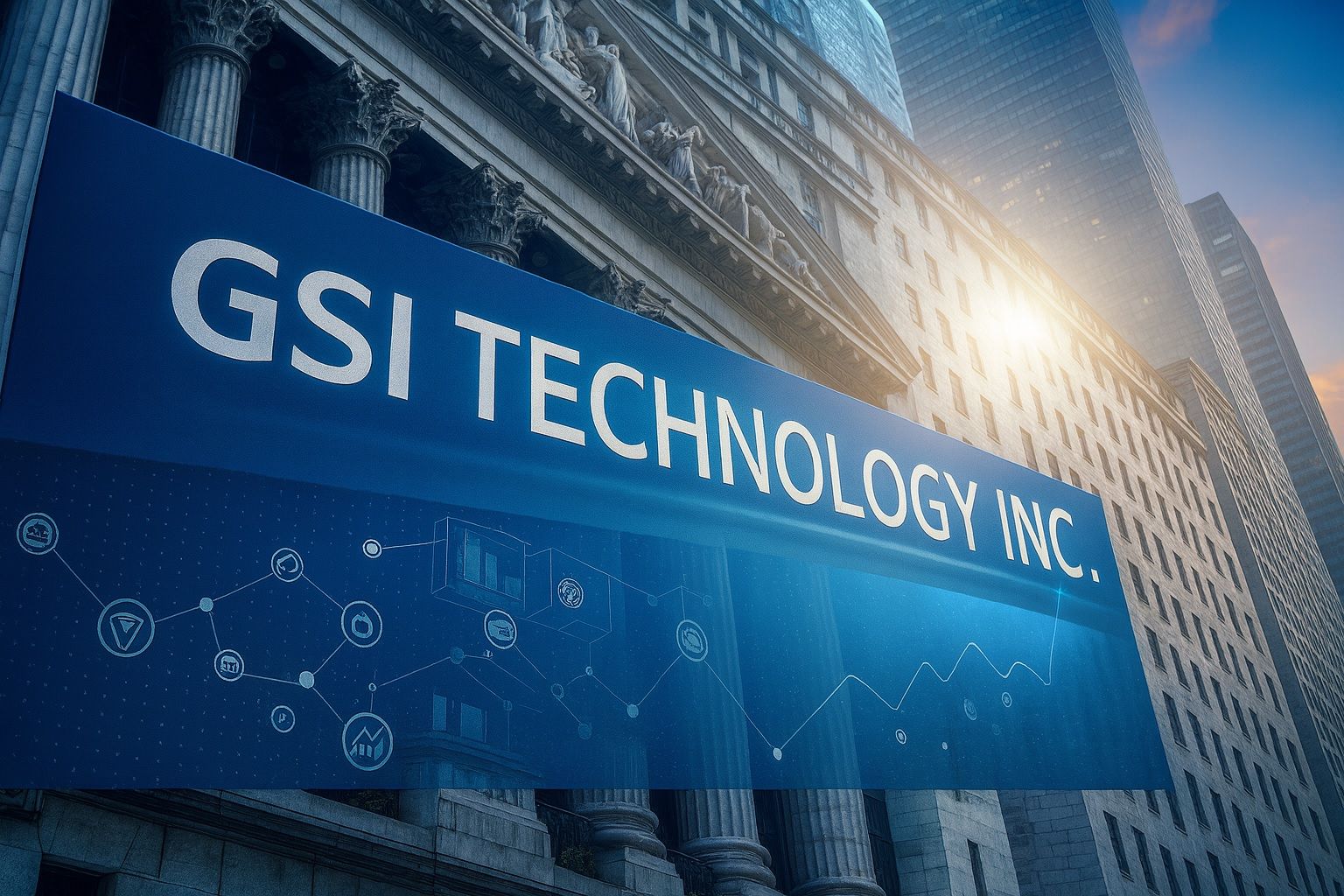- Current Price (GSIT): $12.97 (Nasdaq close Oct 20, 2025), up 155.31% on the day [1]. (Pre-market Oct 21: ~$16.36 [2].)
- 5-Day Performance: The stock traded around $4.6–5.3 for most of last week. On Oct 20 it exploded 155% to close at $12.97 (intraday high $17.48 [3]) [4].
- Market Cap: ~ $148 million (small-cap) [5].
- Company: GSI Technology, Inc. (Nasdaq: GSIT), founded 1995, is a Sunnyvale, CA-based semiconductor firm. It designs AI inference chips (Associative Processing Units, or APUs) and high-performance memory products for networking, telecom, defense and aerospace markets [6] [7]. Its Gemini-series APUs use “compute-in-memory” architecture aimed at energy-efficient AI processing.
Cornell Validation Spurs Stock Rally
On Oct 20, a Cornell University-led study (MICRO ’25 conference) confirmed that GSI’s Gemini‑I APU can deliver GPU-like AI performance using far less power [8] [9]. In benchmarks on large retrieval-augmented generation (RAG) workloads, GSI’s chip achieved throughput comparable to an NVIDIA A6000 GPU while using ~98% less energy [10] [11]. The study also found the APU ran RAG tasks several times faster than standard CPUs (up to 5× speedup or ~80% shorter processing time) [12] [13]. GSI CEO Lee-Lean Shu hailed the independent validation, saying “Cornell’s independent validation confirms what we’ve long believed – compute-in-memory has the potential to disrupt the $100 billion AI inference market,” and that the APU delivers “GPU-class performance at a fraction of the energy cost.” [14].
These Cornell results make GSI’s claims concrete. By performing matrix operations inside memory, the Gemini APU avoids the huge data transfers that slow GPUs and drain power. As Nature recently noted, AI’s energy hunger is a growing crisis, and “hardware that consumes less power will reduce AI’s appetite for energy” [15]. GSI’s second-generation chip, Gemini-II (taped out but not yet shipping), is touted to be even faster and more efficient: the company says Gemini‑II offers roughly 10× the throughput and lower latency on memory-intensive AI workloads [16] [17]. This next-gen APU is aimed at low-power edge-AI use cases like autonomous drones and satellites, where energy efficiency is critical [18] [19].
Stock Price Reaction
Investors reacted with a vengeance. On Oct 20 GSIT’s stock jumped from about $5 to ~$14.80 intraday [20], a gain of roughly 200%. It closed at $12.97, up 155.31% on the day [21]. MarketBeat reports this was a new 52-week high (trading as high as $17.48 intraday, from a prior close of $5.08) [22]. Volume exploded – the closing trades of Oct 20 totaled ~111 million shares (vs. under 1 million just days before) [23]. Early Tuesday morning (Oct 21), pre-market quotes showed the rally continuing (around $16.36, +26% further) [24], though such momentum could reverse once markets settle.
In short, GSIT’s stock skyrocketed on the Cornell news. Analysts say this reflects extreme excitement: GSI’s chip breakthrough tapped into the hot edge-AI narrative, sending a tiny microcap ripping. However, observers also caution that this spike may overshoot fundamentals (see below).
Analyst Views and Caution
Most Wall Street analysts have not covered GSIT closely (it’s a sub-$200M company), but the handful of ratings are bearish. Weiss Ratings recently reiterated a “Sell” on GSIT [25], and MarketBeat notes analysts’ consensus is still “Sell” [26]. No major brokerage has a bullish price target. Indeed, technical-forecast models flagged GSIT as extremely overbought: CoinCodex’s algorithm labeled the stock “very high volatility” and even advised a short position given the unsustainable surge [27]. CoinCodex analysts have speculated the price could quickly retrace to roughly $5 within days [28], though such model-driven forecasts are highly speculative.
On fundamentals, GSI remains a high-risk play. Its annual revenue (~$22M as of 2025) is tiny and recently shrinking, and it is far from profitable (net margin ~–63% [29]). The latest quarter (Q1 FY2026, ended Sept 30) saw revenue of only $6.3M (up 35% year-on-year) and a loss of $0.08/share [30]. In other words, GSI is mostly still selling niche memory chips and not yet generating large sales from its AI technology.
In light of this, some experts urge caution. Industry reports note that AI/defense stock rallies can be a “double-edged sword”, reflecting both real promise and speculative hype [31]. For example, TechStock² observes that other small defense-AI names (like BigBear.ai) have seen rapid runs and pullbacks. “Coverage of growing defense AI deals highlights both opportunity and speculative hype,” warns one analysis [32]. In other words, while GSI’s technology milestone is genuine, turning it into sustainable profits will take time. Until sales materialize, the stock may revert on any sign of disappointment.
On the bullish side, some institutional investors are taking notice. MarketBeat reports that in recent filings, Bank of America and Osaic Holdings massively increased stakes in GSIT (Bank of America’s shareholding jumped 8,248%, Osaic’s by 52.1%) [33]. This suggests at least a few funds see long-term potential. Moreover, GSI’s balance sheet is unusually strong for a microcap: one report notes it has a current ratio of 5.79 and more cash than debt [34]. The company also raised capital in summer 2025 to finance R&D and has added new board members, which could provide funding and oversight. However, insiders (including a vice president) actually sold some shares when the price was around $3–4 earlier this year, underscoring the mixed signals.
Industry Context: AI and Memory Chips
GSI operates in a very niche corner of the semiconductor market. It competes in “compute-in-memory” AI chips, a cutting-edge approach that embeds processing in SRAM arrays to cut power use. This is contrasted with the more mainstream CPU/GPU chips (from Intel, Nvidia, AMD, etc.) that dominate AI today. The Cornell study positions GSI as a potential breakthrough player if its chips can scale. Such technology is often described as a “paradigm shift” for AI computing [35].
The broader market for edge-AI chips is potentially huge: analysts estimate the low-power “edge AI” semiconductor market at roughly $56–57 billion by 2030 [36]. This includes drones, autonomous vehicles, satellites, IoT devices, and military/aerospace platforms – all of which need AI inference with tight energy budgets. GSI has specifically targeted these areas. Its press releases and filings emphasize partnerships with defense contractors and space/avionics customers that could use the APU’s high performance-per-watt [37] [38]. For example, GSI has a U.S. Army SBIR contract to advance edge-AI computing. (By contrast, general-purpose GPU makers like Nvidia and AMD mostly target data-center AI, which doesn’t emphasize extreme power efficiency.)
Other chipmakers are exploring similar paths. For instance, MediaTek’s new Dimensity mobile chip includes a specialized compute-in-memory NPU that claims to cut always-on AI power by ~42–56% [39]. This shows the industry sees real demand for ultra-efficient AI. If GSI’s APU can deliver on its promise, it would justify why investors got excited.
Still, the compute-in-memory space is unproven in mass markets. GSI’s advantage is that it has a working silicon and a peer-reviewed validation, but the challenges of integrating such chips into real products (software tools, system design, manufacturing at scale) should not be underestimated.
Outlook and Investor Sentiment
Investor sentiment on GSIT is extremely bullish but very volatile. On the charts the stock looks parabolic, and technical indicators warn of a quick reversal. CoinCodex’s system called this a “very high volatility” stock and advised caution [40]. Many retail investors who piled in on the hype may either lock in gains or brace for a retrace.
The next key event is GSI’s Q2 FY2026 earnings, due after market close on Oct 30, 2025 [41]. Analysts and investors will look there for evidence of real customer orders for the APU or pipeline deals. So far GSI has only modest revenues and one quarter of early-stage product development under its belt. The press release and Cornell study have set a high bar of expectation; if Q2 results show progress (even small, since revenue is low overall), sentiment may stay positive. Conversely, a lack of new contracts or larger-than-expected losses could trigger a sell-off.
Longer term, the central question is whether GSI can commercialize its technology. If the APU chips can be mass-produced and embedded in high-volume applications, they could upend the power-hungry AI hardware market. As one analyst noted in describing this breakthrough, “managing power often matters more than raw benchmark scores” [42] – in other words, efficiency is the new frontier. GSI’s CEO has already outlined a roadmap (Gemini‑II and a future “Plato” chip) to push throughput even higher while trimming power [43] [44]. Those who believe compute-in-memory will be widely adopted see enormous upside if GSI leads the way.
In summary, GSI Technology’s stock has become one of the market’s most volatile wild cards. The recent AI-chip news and resulting 200% surge have put it in the spotlight, attracting both hopeful bulls and skeptical bears. For long-term investors, the jury remains out. The technology breakthrough is real and intriguing, but success hinges on execution and market adoption. As one report warns, this rally reflects both “opportunity and speculative hype” [45]. Anyone considering GSI stock should weigh the potential of its revolutionary AI chips against the risks of its unproven business fundamentals and extreme volatility.
Sources: Recent financial filings and press releases from GSI Technology [46] [47]; Cornell University Micro ’25 conference proceedings [48] [49]; market data from stockanalysis.com [50] [51]; news coverage by Investing.com [52] [53], MarketBeat [54] [55], The Economic Times [56] [57], and TS2.tech [58] [59] [60].
References
1. stockanalysis.com, 2. stockanalysis.com, 3. www.marketbeat.com, 4. stockanalysis.com, 5. economictimes.indiatimes.com, 6. markets.businessinsider.com, 7. www.stocktitan.net, 8. www.investing.com, 9. economictimes.indiatimes.com, 10. www.investing.com, 11. economictimes.indiatimes.com, 12. www.investing.com, 13. ts2.tech, 14. economictimes.indiatimes.com, 15. ts2.tech, 16. www.investing.com, 17. www.stocktitan.net, 18. ts2.tech, 19. www.stocktitan.net, 20. ts2.tech, 21. stockanalysis.com, 22. www.marketbeat.com, 23. stockanalysis.com, 24. stockanalysis.com, 25. www.marketbeat.com, 26. www.marketbeat.com, 27. ts2.tech, 28. ts2.tech, 29. ts2.tech, 30. economictimes.indiatimes.com, 31. ts2.tech, 32. ts2.tech, 33. www.marketbeat.com, 34. economictimes.indiatimes.com, 35. www.investing.com, 36. ts2.tech, 37. ts2.tech, 38. www.stocktitan.net, 39. ts2.tech, 40. ts2.tech, 41. markets.businessinsider.com, 42. ts2.tech, 43. www.stocktitan.net, 44. ts2.tech, 45. ts2.tech, 46. markets.businessinsider.com, 47. www.stocktitan.net, 48. www.investing.com, 49. economictimes.indiatimes.com, 50. stockanalysis.com, 51. stockanalysis.com, 52. www.investing.com, 53. www.investing.com, 54. www.marketbeat.com, 55. www.marketbeat.com, 56. economictimes.indiatimes.com, 57. economictimes.indiatimes.com, 58. ts2.tech, 59. ts2.tech, 60. ts2.tech










